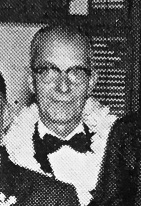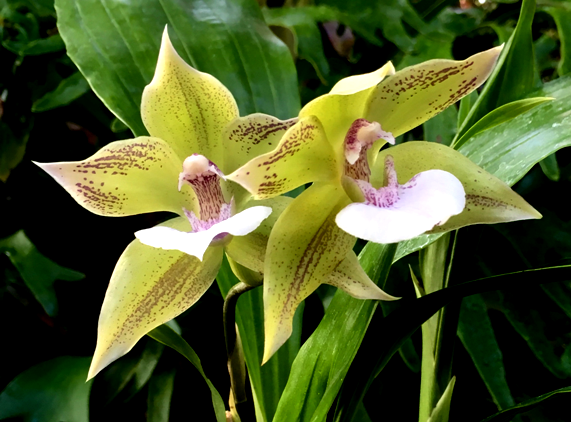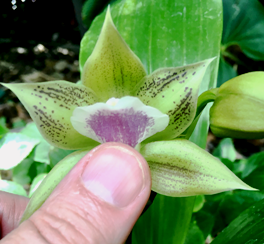South Coast Orchid Society
i-FAQ
Infrequently Asked Questions

Why do we meet on the 4th Monday of the month?
Before there was South Coast Orchid Society, there was the Orchid Society of Southern California (OSSC), meeting on the 2nd Monday of the month in Hollywood (we know this from some early newsletters of OSSC), in the then-new Fiesta Hall at Plummer Park on Santa Monica Boulevard. Orchid growers, both amateurs and professionals, flocked to OSSC meetings. OSSC, one of the founding chapters of the Orchid Digest Corporation, held judging as early as 1949 — we know this from the list of OSSC awards 1949-1955 that is in the collection of the library of the Los Angeles County Arboretum.Now, orchids bloom at odd times. If your wonderful orchid happens to bloom a week after the OSSC meeting, how can you show it off? The flowers will be gone by the time the next OSSC meeting is held. It stands to reason, therefore, that when Paul Baker (living and working in Long Beach, with two greenhouses next to his oil wells hear Long Beach Boulevard and 37th Street, and a member of OSSC) and his friends decided to start a new orchid club in Long Beach, the natural choice of the meeting date would be as close as possible to half-way between the OSSC meetings, on the 4th Monday of the month. The earliest mention of SCOS that we have uncovered so far, an account of our first holiday party, indicates that the next scheduled meeting would be at the Silverado Park clubhouse, on the 4th Monday of the month. These meeting dates, OSSC on the 2nd Monday and SCOS on the 4th Monday, have continued right down to the present day.
SCOS followed the OSSC practices in another way, too. OSSC was meeting in Los Angeles park facilities; SCOS did the same in Long Beach. We also know that a large number of the members of SCOS were OSSC members as well. Many of the SCOS members who are identified in newsletters, meeting summaries published in Orchid Digest or the AOS Bulletin, or in newspaper articles, can be found either in the early OSSC newsletters or in the 1957 OSSC membership list that has turned up in the Botanical Center "orchid archive" at The Huntington. And we can see from the various lists of awards, that as soon as judging was implemented at SCOS, in December, 1954, our members were exhibiting plants and having them judged at the meetings of both organizations.

Howard Anderson at the January 28, 1957 SCOS awards banquet, from an article about the event published in Orchid Digest
Where does our old motto, "Orchids are gracious living — Wear them", come from?
This motto is found on the older SCOS newsletters that were discovered in the "orchid archive" at The Huntington Botanical Center, covering the years 1958-1963 and 1971-1973. It is not found in the February, 1958 newsletter; the first occurrence we know of is in the March, 1958 newsletter. It's origin has been discovered in the OSSC newsletter from March, 1958 (even though the motto itself is mentioned in at least one earlier issue of the OSSC newsletter): "The Orchid Growers Association of America ran a contest for a slogan to use in the stimulation of interest in the use of orchids. Over 100 slogans were submitted and our own Howard Anderson was the winner with: ORCHIDS ARE GRACIOUS LIVING — WEAR THEM."Howard A. Anderson Sr. (June 1, 1890 - October 5, 1979) was a distinguished member of OSSC and also of SCOS. He was very active in orchid judging as well as many other aspects of the life of both societies. He has much greater fame, as one of the pioneers of "special effects" for movies and television. His production company was passed on to his sons in 1954, and his son Howard A. Anderson Jr. led a team that built the 11-foot model of the starship Enterprise for the original Star Trek series, invented the effects used for the transporter beam, etc. There would have been no "Beam me up, Scottie" without the Anderson family! The elder Howard Anderson was the host for a party for the Novice Class of OSSC (the Novice Class, a series of monthly gatherings for beginners at the homes of society members, was another innovation continued by SCOS as well) on August 25, 1957. The party was announced in the August, 1957 newsletter of OSSC: "Mark August 25 on your calendar right now! HOWARD CARRINGTON, Chairman of the Education Committee, announces a treat for the Novice Class on that date. A combined swimming and class party will be held at the home of MR. AND MRS. HOWARD A. ANDERSON, 9312 Bianca, Northridge. There will be swimming from 1 to 2 and the Novice Class meeting from 2 to 4 P.M. Genial Howard loves beauty and arranged his greenhouses so that swimmers in the pool may see the beauty of the orchid blooms through the tinted glass windows. In addition to viewing the Anderson's fine collection of orchids, there will be a discussion on photographing orchid blooms. As a technical camera effects expert, Mr. Anderson knows whereof he speaks when it comes to the subject of photography. Please note that this is not the Sunday following the regular August 12th meeting, but a week later. Those who attended the fine meeting at the home of Dr. Wallar in July reported a most informative and enjoyable session." (Dr. Lloyd Wallar was another SCOS member.)
We know which of the Andersons was the orchid enthusiast, because we have a picture of him at the January 1957 SCOS awards banquet.
How influential was Howard Anderson in the SoCal orchid scene? He was President of OSSC in 1953, and Judging Chairman for that organization in 1954. Toward the end of 1952 (and announced in the AOS Bulletin), the Trustees of AOS formed a subcommittee of the AOS Committee on Awards, "in an effort to provide increased opportunity for members on the West Coast to have their fine orchids judged for American Orchid Society Awards." The members of that subcommittee were Morris Holmquist (active in SCOS and in OSSC, he also presided at the 4th Western Orchid Congress held in Long Beach in 1955; not to be outdone by George Dean Field of SCOS and OSSC, he, too, reported having 4000 Cattleyas, and he operated three real estate offices in Long Beach), Jay A. (Julius Alphonse) Muller (1898-1989, masonry contractor, lived in La Cañada, President of OSSC in 1954; we have not been able to determine if he also belonged to SCOS), Robert Casamajor (one of the founders of the Cymbidium Society of America and recipient of many honors), Howard A. Anderson, and Dr. Etta Gray, MD (active in OSSC). The subcommittee was tasked with conducting AOS judging in January, April, and September, 1953, utilizing the facilities of the Orchid Society of Southern California, with Certified AOS Judges, the first session to be held January 12, 1953 at the OSSC meeting at Fiesta Hall, Plummer Park, 7377 Santa Monica Boulevard, Hollywood, at 7 pm. In other words, Howard Anderson was a member of the team that brought regular AOS judging to Southern California.
He put his movie magic to good use for SCOS again on June 25, 1962, with a screening of "The Orchid and the Grower". Our newsletter had this to say about the event: "We are again fortunate in having one of our own members bring us our program this month. Howard Anderson is an Orchid Judge and a director of the Orchid Digest Corporation and is very well known to all of us. His program will be a color movie he photographed himself. With sound and music, this movie protrays the life history and care of the Orchid. The official showing of this movie was given at the American Orchid Society's trustee's meeting in Portland on May 24th and from all the excellent reports this should be a very enjoyable program."
Howard Anderson was not the only SCOS member to make an orchid movie! Jimi Fox, another of our past presidents, made a movie about growing Cymbidiums in 1992, but that's another story.

Ink. Cheyenne Marie 'Midori'
What is an Ink.?
There was a time when it was possible to keep up with the abbreviations for orchid intergeneric hybrids. Lc. was Laeliocattleya, easily remembered as a hybrid between a Laelia and a Cattleya. Those days are long gone! Instead, two trends have conspired to expand the list of intergeneric names and their abbreviations into the hundreds.First, orchid growers have been busy trying all possible combinations of crosses involving genera that used to be the province only of "species specialists". Every time a new genus is successfully added to the gene pool within a particular "alliance", for example, the group of genera that interbreed with Zygopetalum, the number of possible intergeneric combinations grows. The technical situation is that the number of possible intergeneric combinations grows as N! (read this as N factorial). If you have forgotten your high-school math,
- 2! = 2 x 1 = 2,
- 3! = 3 x 2 x 1 = 6,
- 4! = 4 x 3 x 2 x 1 = 24,
- 5! = 5 x 4 x 3 x 2 x 1 = 120,
- etc.
The second issue is that once-familiar genera such as Odontoglossum and Laelia have suffered (we think that may be the correct term) severe and sometimes catastrophic reorganizations. The old Odontoglossum that we learned to love in such classic orchid textbooks as Rebecca Northen's Home Orchid Growing (3rd edition, 1970) was split into about a dozen different genera that we still struggle to remember, one of which was still called Odontoglossum. More recently, even those species that had somehow survived as the much-truncated genus Odontoglossum were unceremoniously dumped into Oncidium, or else were reassigned elsewhere, with the result that there are, officially, and in spite of a determined rear-guard action by a number of growers, NO MORE ODONTOGLOSSUMS at all! And with the disappearance of Odontoglossum, PRESTO! — all of the intergeneric names involving the old Odontoglossum have offically disappeared as well!

Ink. Cheyenne Marie 'Midori', showing the underside of the lip
So, welcome to the new world of intergeneric hybrid genus names! One of them is Ianclarkara, abbreviated Ink., representing any hybrid that contains Aganisia, Pabstia, Zygopetalum, and Zygosepalum. The one Ink. we've seen, Cheyenne Marie 'Midori', came to our attention as a raffle plant a few months ago at a meeting of the South Bay Orchid Society. It has turned out to be a healthy little plant that produces relatively large flowers, but, perversely, the best color is hidden on the underside of the lip! We can't wait to see what the hybridizers will come up with next!
There's no way you can keep up with all the intergeneric names without a trip to the internet. Any list you find in print will be out of date before the Ink is dry. The Royal Horticultural Society (RHS), the official arbiter of orchid hybrid genus names, has posted a "One-Table List of Genera and Intergeneric Hybrids". We don't know how often the list is updated, and the list includes all the intergeneric names that have ever been validly used, even those that are now "empty" because one or more of the component genera no longer exist. The list runs to almost 100 pages, closely spaced. We also found a list of the official abbreviations for the hybrid genera, current as of 2017, but, unfortunately, the list is alphabetic by the full name of the hybrid genus, rather than alphabetic by the abbreviated name. Consequently, it can be difficult to locate the abbreviation you have just found on a plant label! If and when the RHS is able to present the accepted hybrid genus names and abbreviations in a more usable format, we will post the information here.
Copyright 2019 South Coast Orchid Society, Inc.